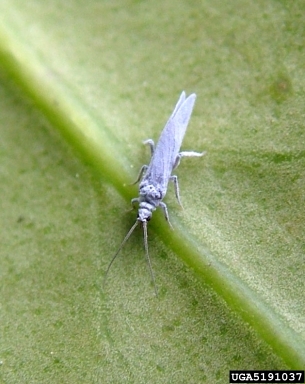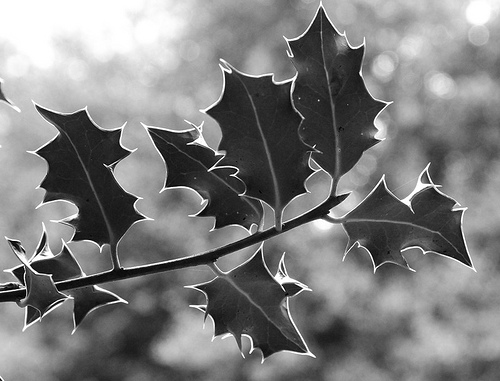Friend or Foe?
In its natural habitat English Holly is a useful member of the
community. Holly berries are an important food source for
birds, as well an occasional snack for
sheep,
goats,
and a number of
deer
species. In exchange for nutrition, animals
that ingest Holly berries complete their mutualistic
relationship by contributing to its reproduction and widespread
distribution. As an English Holly tree
grows larger, some of its branches may touch the ground and take
root. As these branches become thicker and more numerous they
can provide shelter for larger animals in the vicinity or even
become a playhouse for small children.
There are a number of pests that can plague English Holly and affect its
growth and reproduction. Aphids, which are small, slow-moving insects that suck
the fluid from a number of plant species, can cause deformed leaves and leave
the Holly plant vulnerable to viruses. The larvae of moths, beetles, and flies,
often called leaf miners, can burrow into the leaves of Ilex aquifolium
and create a pathway of damage through the tissues of the leaves.
Unlike the mutualistic relationships that many plants have with fungi, English
Holly experiences a number of diseases caused by the Fungi kingdom. Black Root
Rot, caused by the fungus Thielaviopsis basicola, can stunt plant
growth and spreads quickly by means of mycelium and wind dispersed spores. If
the fungus continues to thrive the plant will slowly decline and eventually die.
Phytophthora cinnamomi and Armillariella mellea both cause
similar, but less common
root rot diseases. These types of root rot require
specific conditions to occur and seldom result in the death of the plant. A
number of leaf spot diseases, also caused by fungi, occur in members of the
Holly family. It is uncommon, however, to see these leaf spot diseases in
English Holly.

Figure 1: An insect taking shelter on an English Holly leaf.
As for humans, Ilex aquifolium has
both uses and dangers. One of the most important things to know about this
species is that the berries contain a number of toxins that are harmful to
humans. The most important of these toxins is saponin, a chemical commonly used
in soaps and detergents. Other toxins include phenolic, a compound used in
plastics and high pressure laminates, and alkaloids, which are commonly used in
anesthetics and stimulants. Human ingestion of berries can cause a variety of
gastrointestinal symptoms including nausea, vomiting, abdominal pain and
diarrhea. Children experience all of these symptoms as well as stupor and
drowsiness.
Despite the unpleasant symptoms created by ingestion of Holly berries, they are
many ways that the berries, as well as the leaves and the bark of the tree, can
be put to good use. Although it is rarely used in modern herbalism, English
Holly was once a very popular medicinal plant.
Ilex aquifolium berry, although
poisonous in large amounts, can be used to treat swelling due to excess fluid
build-up. They may also be powdered and used as an astringent to check for
bleeding. Roasted English Holly fruit was once used as a coffee substitute, but
only when exercising extreme precaution.

Figure 2: Holly branch with leaves.
Holly leaves can be used to treat a number of ailments. They are known to have
astringent, diuretic and expectorant effects. In other words holly leaves can
diminish blood loss, increase urine discharge and increase the expulsion of
mucus from the lungs. In some cases the leaves are used in the treatment of
fevers, rheumatism, cararrh and pleurisy. Those who have suffered from jaundice
have found the juice from the leaves to be an acceptable treatment as well.
Last, but certainly not least, is the use for Holly wood. Holly wood is a hard,
dense material that, when well dried and seasoned, can be used to make beautiful
furniture. Although it can be difficult to work with it is highly regarded by
cabinet makers because of its beautiful white look after it has been polished.
As trees grow older the wood begins to turn a brownish color, but it is still
used for printing blocks and engravings.
Holly
and the Christmas Spirit...
|